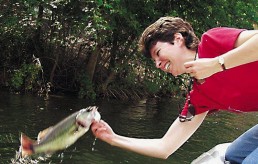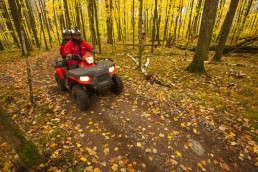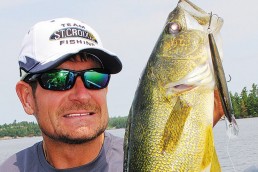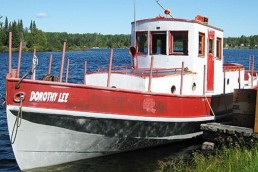Not too Early to Plan Ozark Vacation
There is a reservoir about 450 miles from the Chicago area that has more miles of shoreline than California has coastline. A mecca for all watersports, this serpentine body of water meanders through oak-studded hills in the Ozarks.
The reservoir is Lake of the Ozarks, with its 1,150 miles of shoreline, dwarfs California’s coastline of 840 miles.
For hundreds of years, the Delaware and Osage Indians inhabited the area living off the abundant wildlife along the rivers. When the French and Spanish trappers arrived, they began harvesting animals that had been the Indian’s sustenance for generations.
Life was good for many years, as highways and railroads came to the area, and even those who could not work found it easy to live off the land. Bass, carp, catfish, paddlefish and walleyes were plentiful in the river system.
Damming the Ha Ha Tonka spring creek in 1911 created a cold-water pool. Named one of the “Seven Wonders of Missouri,” in 1929 it became a trout-fishing haven for tourists. Union Electric completed Bagnell Dam in 1931, and by 1934 Lake of the Ozarks was full, as resorts, motels and other businesses thrived.
Through the 1940s and 1950s, fishing at Lake of the Ozarks was phenomenal, with bass, catfish, and walleyes being prime targets. In fact, guides in the 1950s guaranteed limits of fish or the client did not have to pay. Fishing pressure and the lack of habitat took its toll and stronger management practices became necessary.
Since then, steps taken by the Missouri Department of Conservation (MDC) have improved bass and crappie populations and rejuvenated the spoonbill and walleye fishery.
“My main objective is to keep tabs on the fishery at Lake of the Ozarks,” said Greg Stoner, who has been the MDC fisheries management biologist at the lake for 24 years. “We do routine walleye population sampling and brood stock collection in the spring, a bass population survey in April and a crappie survey in the fall.”
Much of this information becomes part of the MDC Annual Fishing Forecast for anglers.
“We’re looking at the crappie growth rates now. Several people have questioned why the legal length isn’t 10 inches instead of 9, thinking a 9-inch fish is too small to keep. When that regulation went into effect it was based only on growth rates,” Stoner said.
Based on comments from anglers, he is studying the crappie population in the Glaize, Gravois, and Niangua arms plus the upper Osage to determine if a change in the legal length limit is needed.
“We stock walleye(s) one year and hybrid stripers the next, plus pure stripers every five years, and paddlefish every year,” he says of adding other species. “Since 1995, the MDC has stocked over 1,465,000 hybrid striped bass, 641,000 striped bass, 34 million walleyes and 295,000 paddlefish in the lake.”
A major accomplishment in 2013 was the change to blue catfish regulations that went into effect March 1 of that year. Approved changes included 10 blue catfish daily, a protected slot-length limit of 26 to 34 inches (fish within the slot must be returned to the water unharmed immediately) and two blue catfish larger than 34 inches—the two fish count toward the daily limit of 10.
This rule change protects blue catfish during their highest growth rate and will eventually increase the size of the average fish caught.
Another major accomplishment in 2013 was the involvement in relicensing Ameren, and the subsequent 2-inch mesh barrier net placed in front of Bagnell Dam. An untold number of large fish had been going through the gates, but the net has eliminated this problem.
With the lake 83 years old, no submerged timber or trees remain to provide habitat for fish. Some residents and frequent visitors sink brush to augment habitat.
“Most of the fish attractors that folks put around their docks are made of natural material such as hardwood limbs bound together, or cedar, Christmas trees or PVC structures. PVC attractors are durable and are not as prone to snag a lure as a cedar tree, but woody attractors pull in more fish,” Stoner said.
He would like owners to submerge the largest “woody” material they can handle safely. Christmas trees work but they decompose in a few years. A cedar tree with a 6- to 8-inch diameter trunk may last a decade or longer. The more woody mass you have, the more fish you a likely to attract.
Visiting anglers should use their electronics to locate and fish submerged brush for bass, bluegills, crappies and an occasional walleye.
The angling future looks bright for the lake. Stoner will monitor the catfish to ensure the regulations are achieving the desired results, plus he will continue assessing the crappie growth and longevity.
It is not too early to plan a spring or summer vacation at Lake of the Ozarks, prime times are reserved quickly at the lake’s best accommodations.
For more information…
Visit funlake.com or for information on a resort near the dam or shopping and attractions go to: thealhonnaresort.com.
MWO
SHARE THIS POST
Did you enjoy this post?
You can be among the first to get the latest info on where to go, what to use and how to use it!
Darrell Taylor
Darrell Taylor has fished for more than 65 years. During the past 25 years, Taylor has generated more than 2,000 published articles, columns and fishing reports. His writings received 14 peer-level awards from outdoor writer organizations, including the Association of Great Lakes Outdoor Writers “Excellence in Craft” Golden Glow Award, their highest recognition.



